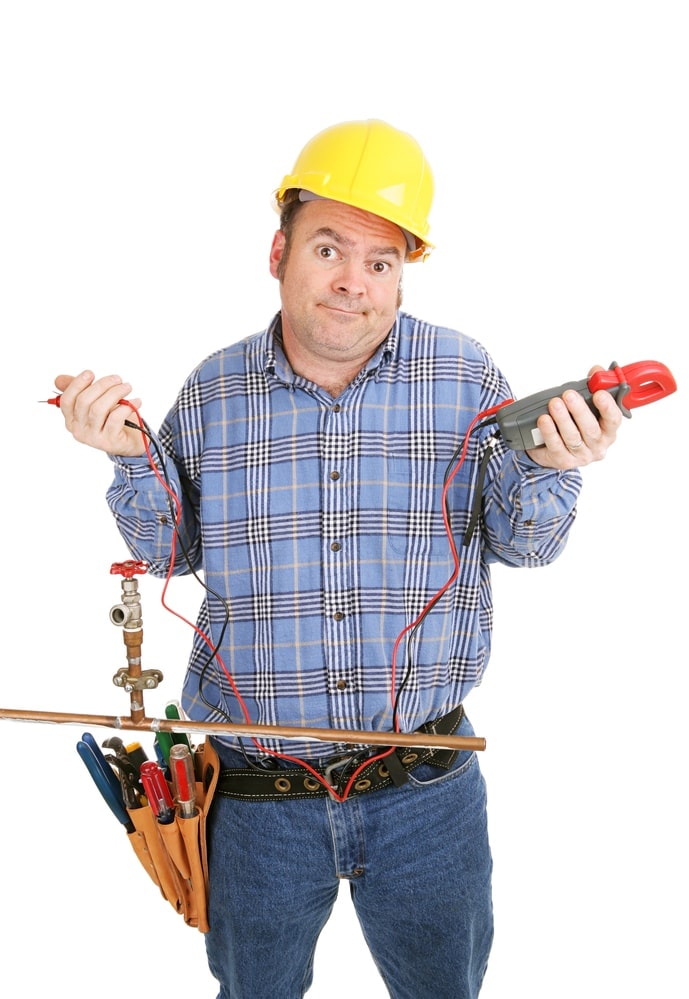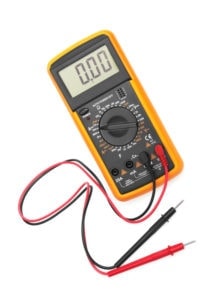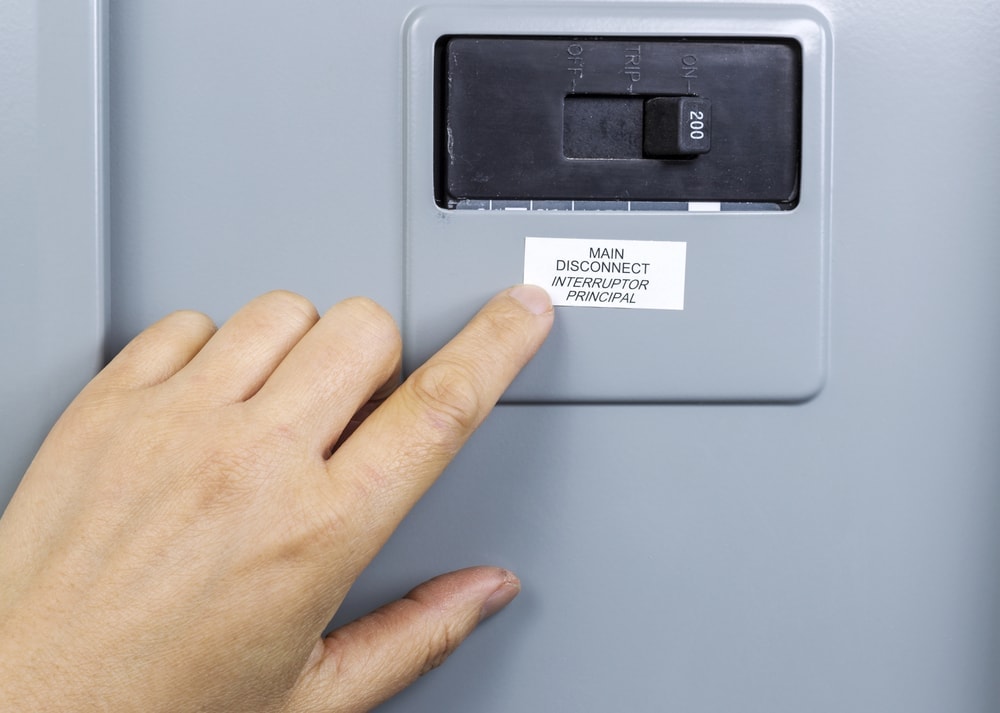This post may contain affiliate links. Please read the disclosure for more info.
For over ten years I have been doing my own electrical work around the home that ranges a full panel rewire, various install, installing a sub-panel in my garage to wiring a new addition on my home. Over the years I have had my fair share of being shocked with 120 volts and while I never had any serious repercussions some of those hurt a lot! As you can imagine I learned my lesson and know what not to do when performing my own electrical work; which includes the right precautions to take while doing electrical work.

Can you still get shocked if the breaker is off? The short answer is Yes! There are many factors that come into play that can cause you to still get shocked when performing electrical work even though you have shut off the breaker to the area that you are working on. The most common issue is when the breaker is incorrectly labeled. Do not trust the breaker and always use an electrical testing tool, that is in good operating condition, prior to dealing with any electrical situation. It is recommended to always check the wires with a voltmeter since a non-contact voltage tester can be misleading. While some electrical shocks are unpleasant some can be deadly. Be sure to always practice safety precautions when dealing with electrical projects.
Since there are other factors that can contribute to being shocked even with the breaker off and to understand the necessary precautions to take when dealing with electrical projects continue reading below.
Jump To:
What causes a shock even though the breaker is off?
There are several factors that can contribute to receiving a jolt of electricity when performing home repairs, electrical work or even demolition. The most common is shutting off a breaker and not using a tester to ensure all the wires are not live. We will talk more about non-conductive voltage testers (NCTV) or voltage meters, but for now just know they are used to sense a voltage source. If you fail to use one of these to test the voltage it is possible that inside the electrical box there are live wires, the breaker you shut off was wrong (most common), someone else turned it back on, or it is possible that there is live circuits whose wires are running next to the wires you are working on. Don’t forget that a wire whose insulation has been corrupted either by burning, melting, friction can expose the internal wiring leading to possible injuries, or even worse. Remember 0.1 – 0.2 amperes or around 17 milliamps are considered lethal and can electrocute someone! A lot has to do with how the current enters, flows through and exits the body.

Another cause for a shock even though the breaker is off can be due to a double fed circuit. A double circuit feed is when two circuits on the same phase are wired together to feed a single device. This can be done on accident or can occur as part of remodels or changes to existing wiring over time. This results in a breaker that is turned off and another breaker continues to feed to circuit and this can result in an electrical shock if you do not test for voltage before handling the wires. For example, if you have circuit in your master bedroom and it shares a wall with your master bathroom. If someone happens to wire the outlets between the two rooms together with a jumper then those circuits could feed each other when one of the breakers are turned off. You would have to know exactly which two breakers to turn off at the same time in order for you to avoid an electrical shock or you can turn off the main which would kill the power to the entire home.
For the much older homes that still have knob and tube wiring it is possible for the non-insulated copper wires that are attached to two porcelain insulators tend to stretch and sag over time where they contact other parts in the wall, moisture, metal box or any conductive material resulting in an electrical shock.
Finally, you may get an electrical shock while the breaker is on from a shared neutral wire. The reasons for this can vary but it could be from a shared neutral in another circuit or it could be from a multi wire branch circuit (MWBC). The potential shock comes from working with the neutral wires that you thought were dead wires by turning off one breaker.
How to avoid an electrical shock?
First, before you begin any project especially demolition or electrical work be sure to inspect the surrounding areas and take precautions with demolition that could expose or cause you to encounter live electrical wiring or conductive materials. Next consider the electrical work you are doing. Be sure to check the breaker is off and grab your non-contact voltage tester (NCVT). The NCVT will light up at the presence of AC voltage by sensing the electromagnetic field around a live wire. What I love about NCVT’s is you don’t have to contact an energized conductor since these instruments are so sensitive that they will beep or light up when you are just close (not in contact) to a voltage source. The voltage source could be a live wire, an energized piece of metal or other conductive material, a light switch, or an outlet. Before I trust my NCVT I always check it on a source that I know is live like an outlet or a live wire. Once I know it is working properly, I check the area that I will be working with. If it’s a receptacle or a light switch, I will check the box, any metal surroundings, any wires I see including those that are running near the area I am working.
I strongly recommend anyone remodeling a home, doing home repairs or maintenance, or working around electrical components purchase and become very comfortable using a digital multi-meter (DMM) with a NCVT feature. A DMM with NCVT can perform many electrical tests, keep your home in peak operating condition while keeping you safe from possible electrical shocks.
Quick note about a DMM and what you can use it for:

- DC voltage testing: Use a DMM to test the voltage of batteries in portable devices to understand how much power is left.
- AC voltage testing: Use a DMM to test your ground, power, ground to ground and ground side of the outlet (neutral).
- Is the wire conducting electricity? Use a DMM to test for hot wires vs ground wires where in older homes they are both black by using a known ground.
- How much current is flowing through the wires? Use a DMM to determine the amount of current or amperes are flowing through a wire
- Solenoid valve operation: Appliances like a washing machine or dishwasher that use water have a solenoid valve (a valve opened and closed with a small electromagnet) to open and close are susceptible to small breaks in the solenoid’s coil that will cause the solenoid valve to quit working. While you can’t see the break, you can use a DMM set on the Ohm setting to check if it has stopped working and know you must replace it. You will need to know the specs for the solenoid beforehand to understand if the measurement is indicative of a break.
Finally, I strongly recommend using tools with rubber grips or handles as just a good general rule to help reduce any possible risk of electrical shock due to conducting an electrical current through a tools handle and then your body.
Is it OK to turn off the main breaker?

Yes, it is OK to turn off electricity at the main breaker without harming any other breakers or electrical components, however, keep in mind that abruptly shutting off the main breaker will kill power to all electrical components in the house like HVAC and computers, that may require resetting or rebooting once you turn the power back on. Also, keep in mind that you will have no lights, possibly no hot water, and it could impact your safety working around your home. If you are unsure how to kill power to a circuit for repairs or maintenance, you can kill the main power to work safely while you figure it out.
Please keep in mind that if you are not familiar with the wiring of the home or basics of residential electrical wiring please consult a professional electrician.

